The PolarTREC Field Experience
PolarTREC (Teachers and Researchers Exploring and Collaborating) is a program that pairs US educators with field research experiences in polar regions. The program is managed by the Arctic Research Consortium of the United States (ARCUS) and receives funding from the National Science Foundation (NSF) Office of Polar Programs. The long-term vision of PolarTREC is "to create and sustain a successful approach to professional development in the polar regions, fostering enthusiasm and awareness to inspire the next generation of scientists and a STEM-literate public".1
Field research experiences such as PolarTREC represent the absolute best form of professional development for science educators. Through my experience, I was able to:
Increase my knowledge of polar regions and their role as a critical bellwether of climate change.
Engage in field research, learning more about it in the process.
Foster a long-term professional collaboration with the research team with whom I worked.
Bring gained knowledge and experience back to my students through new classroom lessons, activities, and projects.
Bring gained knowledge and experience to my broader community, to promote enthusiasm for polar science among the public.
Research Background
Arctic permafrost is melting at an unprecedented rate, unlocking large amounts of carbon, which becomes part of Arctic watersheds as dissolved organic carbon (DOC). A recent study suggests that a rise of 1°C in surface temperature equates with the loss of 1.5 million miles of permafrost.2 Estimates indicate that surface temperatures in Alaska have increased by up to 2°C over the last 20 years. In 2016, Arctic permafrost temperatures were the highest ever recorded.2
The organic material unlocked as DOC when permafrost thaws is exposed to soil microbes and sunlight, which serve to convert it to either CO2 or methane. These are greenhouse gases, and their increased presence in the atmosphere serves to worsen global warming.
DOC can be partially oxidized or completed oxidized to CO2, and studies suggest that sunlight plays a greater role in this process than bacteria.3 DOC contains a wide variety of organic molecules; of these molecules, research suggests that aromatic compounds are more difficult for bacteria to break down, while aliphatic compounds are much easier (more labile).4
Studies have also found that the general breakdown of organic content within Arctic soil differs based on depth. Surface (organic mat) layer soils in the Arctic tend to contain a greater concentration of larger, more oxidized, aromatic organics. Deeper permafrost, on the other hand, tends to contain a higher prevalence of smaller, less oxidized, aliphatic compounds.5
Photo-Bio Project Summary
The main project on which I worked while at Toolik Field Station was the summer photo-bio project, a collaboration between Dr. Rose Cory (University of Michigan), Dr. George Kling (University of Michigan), and Dr. Byron Crump (Oregon State University). This work also constitutes a major part of the graduate work of Natasha Christman (Oregon State University).
The photo-bio project attempts to answer three critical questions:
How does DOC chemistry affect the metabolic processes of microbes?
How does DOC exposure to sunlight factor into this equation?
How does long-term microbial community adaptation affect the rate of DOC breakdown?
To address these questions, three soil pits were excavated in wet sedge tundra down to 1.2 meters. From each soil pit, samples were taken from two categories of soil, based on depth: surface (organic mat) layer (10-30 cm in depth, proceeds through freeze-thaw annually) and permafrost (80-120 cm in depth, frozen for at least two years).
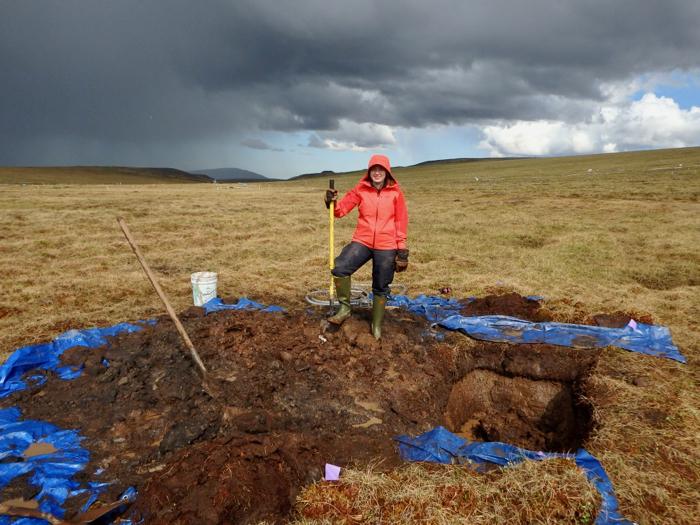
Filter-sterilized DOC was prepared from these soil samples via solid-liquid extraction (basically, preparing tea from soil) and subsequently filtered to remove all microbial content. This DOC was then reinoculated with a set amount of microbial material from the same sample site and depth and inbucated for seven days. To address the role of sunlight in DOC breakdown, the incubation sequence was expanded to include two categories of filter-sterilized “DOC tea” – dark control (foil wrapped) and sunlight-exposed (12-18 hours).
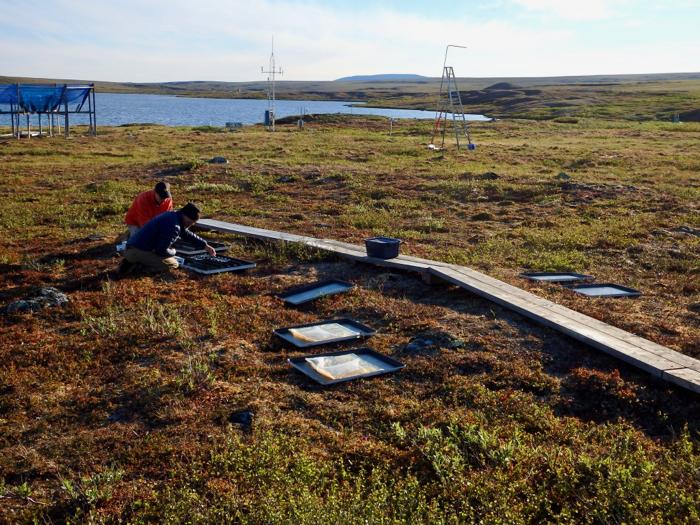
Microbial gene abundance and expression patterns will be evaluated through metagenomics and metatranscriptomics on samples taken at the beginning and end of the incubations. The goal here is to evaluate and quantify the microbial enzymatic reactions used to break down DOC.
To identify the specific formulas of the compounds in the DOC that are being consumed and produced during the incubations, mass spectrometry will be used. In addition, spectroscopy was utilized to measure absorbance and fluorescence of the samples at different points.
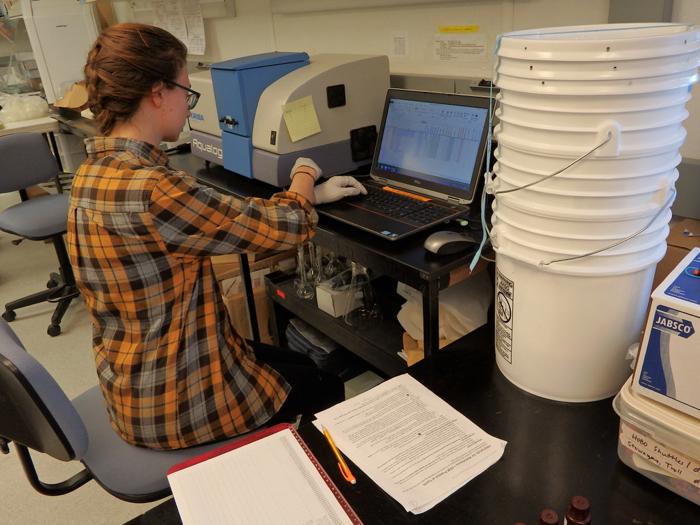
To look at microbial community adaptation, data was collected on microbial abundance, CO2 production, O2 consumption, and microbial community composition at the beginning and end of the incubation periods for both dark and sunlight-exposed samples.
Arctic Land-Water LTER Summary
I also frequently assisted with Long Term Ecological Research (LTER) work at Toolik. The research goals of any given Long Term Ecological Research (LTER) site specifically address the most critical questions of that location. In the Arctic, the main objective is to gather data to allow for better prediction of Arctic response to climate change and other disturbances. Research is themed around a core organizing question – how is the response of Arctic ecosystems to disturbances affected by openness and connectivity between terrestrial ecosystems, streams, and lakes?6
Given this organizing question, Arctic LTER work at Toolik Field Station is categorized into four main sub-groups – terrestrial ecosystems, streams, lakes, and landscape interactions. Dr. George Kling, with whom I worked, heads the landscape interactions sub-group.
The main goal of the landscape interactions sub-group is to assess how downstream ecosystems are affected by upstream/upland materials and species.6 A large portion of the work of the landscape interactions team takes place on the inlet and outlet streams of Toolik Lake. On samples of this water, they conduct a very large battery of tests - pH, conductivity, discharge (flow rate), dissolved gases, dissolved cations (e.g. iron, sodium, potassium, calcium), dissolved anions (e.g. chloride, sulfate, nitrate), particulates (carbon, nitrogen, and phosphorus), and chlorophyll. They even conduct photochemical analyses on samples, such as absorbance/fluorescence spectroscopy. On lakes in the area, the landscape interactions team collects light profile and dissolved gas data at multiple depths. There are 25 total water sample sites, and over 1000 samples are collected in a given field season.
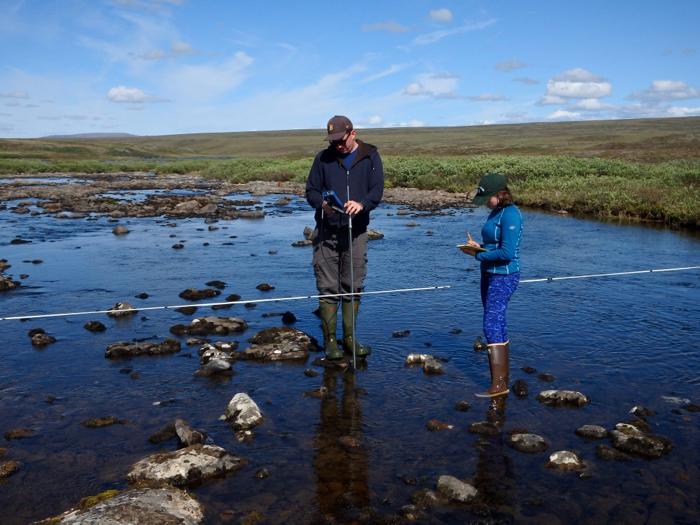
The group also evaluates groundwater flow by modeling how soil water flows through catchments, assesses the landscape distribution and dynamics of microbes, evaluates the chemistry of soil water in water tracks on the tundra slopes, and takes thaw depth measurements at various locations throughout the season.
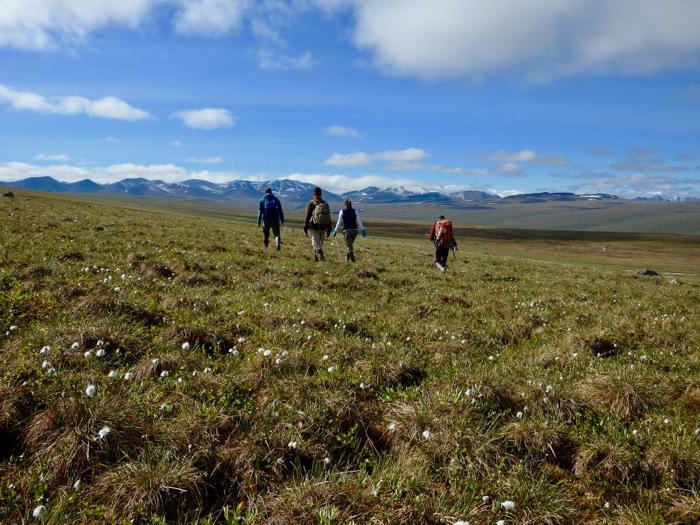
Connecting to the Classroom
So much of the work I conducted at Toolik is directly applicable to my teaching. Below is a comprehensive list of different topics and how they relate.
Geobiology of Climate Change – In my geobiology class, I focus on how the physical world has impacted the biological world throughout geologic time. Our first unit in the course is on the geobiology of the Anthropocene, the age in geologic time defined by humans and our drastic impact on the world. I plan to turn what I’ve learned from my research experience into a critical part of this unit. Thawing permafrost and how this contributes to climate change constitutes an excellent example of how physical changes are directly leading to changes in the biodiversity of the planet.
DOC Chemistry – Arctic dissolved organic carbon (DOC) contains a wide variety of organic molecules (lignins, condensed aromatics, lipids, tannins, unsaturated hydrocarbons, peptides, carbohydrates, and amino sugars, along with many other aliphatics). DOC gives Arctic streams their characteristic color. In my organic chemistry class, I deal directly with the organic chemistry of color. Electrons within organic molecules form waves called molecular orbitals. When a compound absorbs energy, electrons are promoted (excited) to higher energy molecular orbitals. For most organic molecules, the absorbed energy is within the ultraviolet region of the spectrum. Accordingly, most organic molecules absorb ultraviolet light, reflect the entire visible spectrum, and appear white as a result. Compounds with higher degrees of electron delocalization have more overlapping regions of electron density. As a result, these compounds have more molecular orbitals. These molecular orbitals are more similar to each other in energy, and less energy is required to promote electrons to higher energy molecular orbitals. So, compounds with more electron delocalization absorb less energetic light. It follows that if a compound has enough electron delocalization, the energy absorbed is no longer in the ultraviolet range, but rather in the visible range. If a compound absorbs energy in the visible range, it no longer reflects that entire range back to the viewer. Instead of appearing white, it now appears colored. The compounds in DOC and the photos I have of colorful Arctic streams provide an excellent connection between the content I teach and current research on climate change.
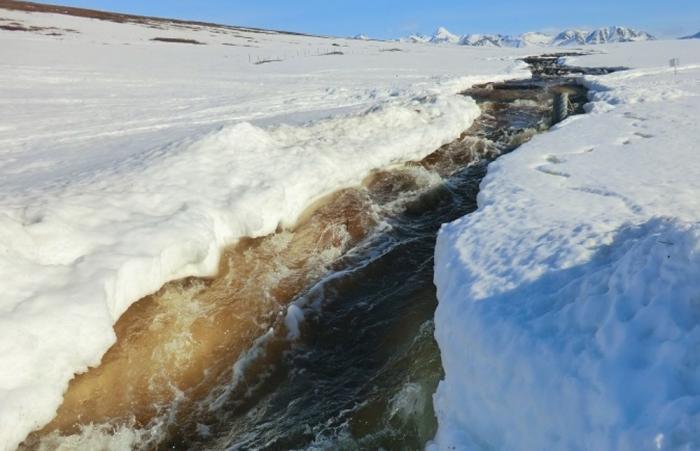
DOC Oxidation Mechanisms – In my organic chemistry course, we study various mechanisms by which organic compounds are oxidized. I learned a great deal this summer about how sunlight served to oxidize DOC in the Arctic, and all of this is directly relatable to what I teach. Photooxidation from sunlight exposure represents a major pathway by which DOC is oxidized to carbon dioxide. Due to its high degree of electron delocalization, DOC is able to absorb a wide breadth of energy from sunlight, both in the ultraviolet and visible range. When a component of DOC absorbs energy from the sun, electrons in the molecule are promoted to higher energy molecular orbitals, and the molecule adopts an excited state. At this point, there are two potential outcomes:
- It is broken down directly into simpler constituents.7
- It reacts with water, oxygen, and iron in the water to yield peroxides, superoxide, other reactive oxygen species, and oxygen radicals. Here, a critical reaction is the photo-Fenton reaction, in which iron reacts with hydrogen peroxide to yield oxygen radicals. Reactive oxygen species are in turn responsible for partially or completely oxidizing DOC, even DOC not originally susceptible to direct photochemical degradation.7
Solid-Liquid Extraction – Solid-liquid extraction represents one of the most important ways by which organic chemists isolate natural products. In my organic chemistry course, students utilize this technique in many of the labs we complete. This summer, I helped out with solid-liquid extractions of Arctic soils to yield DOC leachates. I can use the knowledge I gained to craft labs in which students create leachate from local soils and analyze the product.
Solid-Phase Extraction – Prior to this summer, I had no experience with solid-phase extraction. This method was used by Dr. Rose Cory to concentrate DOC from permafrost leachate. This important method directly relates to many of the techniques my students learn in my organic chemistry class for the concentration of organic compounds.
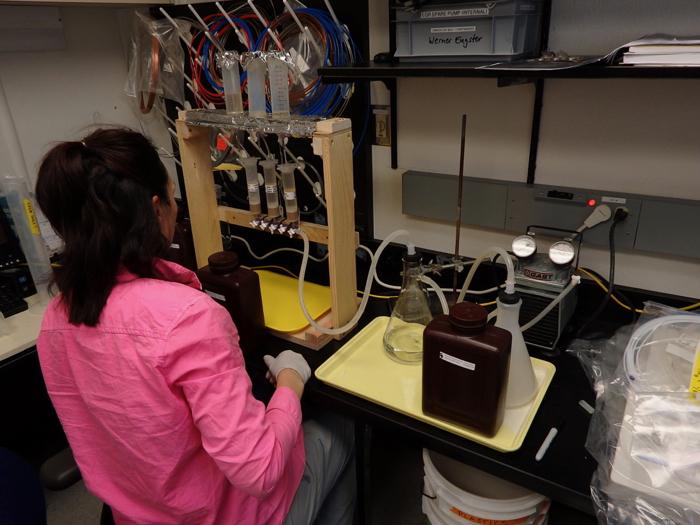
Mass Spectrometry – Mass spectrometry represents a valuable technique by which organic chemists elucidate the molecular formulas of unknowns. Through my work this summer, I learned a great deal about this technique and how it is used to characterize DOC. If you use a mass spectrometer with a sufficiently high resolution, you can obtain the molecular weight, hydrogen/carbon ratio, and oxygen/carbon ratio for compounds in a mixture.89 Molecular weight, hydrogen/carbon (H/C) ratio, and oxygen-carbon (O/C) ratio can be used to determine compound class. Van Krevelen diagrams, which plot H/C ratio as a function of O/C ration, are also very useful in graphically depicting the different components in a mixture.
Gas Chromatography – Dr. George Kling utilizes gas chromatography to assess the CO2 and methane content dissolved in the waters of Arctic streams and lakes. Over the course of my month at Toolik, I learned how gas samples are prepared from stream/lake water. As I have a gas chromatograph in my organic chemistry classroom, I can now write labs in which my students evaluate the water from local rivers and streams for dissolved gases.
Spectroscopy – Dr. Rose Cory utilizes and absorbance-fluorescence spectrometer to characterize the DOC present in soil samples in the Arctic. Similarly, I can have my students use UV-Vis spectroscopy to evaluate DOC content in local rivers and streams.
Experimental Design – The design of the photo-bio project was very complex, with many different things going on concurrently. Participating in this project constituted a great learning experience for me in terms of understanding effective experimental design and observing how a complex project is actually carried out in the laboratory.
Careers in Field Science – My experience at Toolik exposed me to a wide variety of careers and summer work opportunities in Arctic field science. I can now share these opportunities with my students to engage them in the classroom and give them different options for future pursuit.
Community Outreach
Prior to my research experience, I was able to cultivate a wide community following through a variety of mediums, including social networking (Facebook, Instagram, Twitter), statewide networks (Texas Classroom Teachers Association, Texas Alliance for Geographic Education, University of Texas College of Education), local networks (Travis Audubon, LASA High School, Austin Independent School District), and local news (KVUE Television Station, Spectrum Cable News, Austin Monitor Print News).
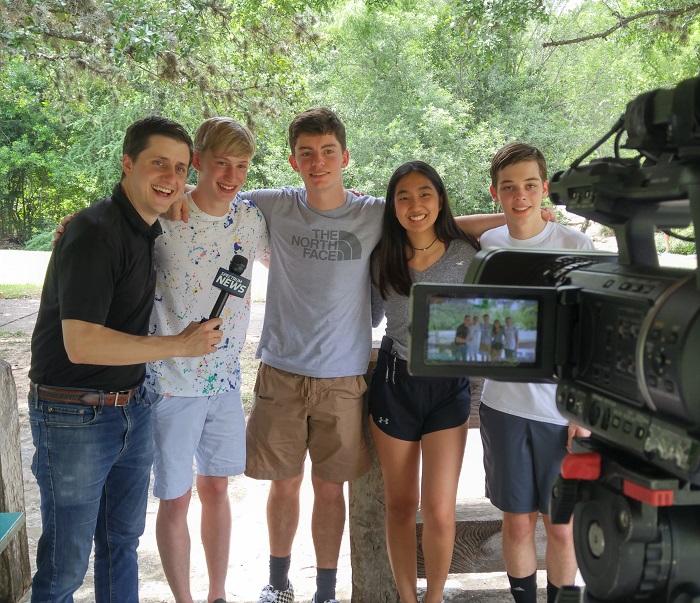
During my time at Toolik Field Station, I engaged in community outreach through social networking, regular journal postings, live video broadcasts and Q&As, and live formal presentations.
Following my research experiences, I have continued to engage my community in polar science through school and community presentations, radio and video news (KUT, Austin’s NPR Station), and print news (Association of Texas Professional Educators News Magazine).
Future Plans
I am in the process of creating two formal inquiry-driven projects for my students, based on the research I conducted at Toolik Field Station. I plan to present these lessons at the National Science Teachers Association (NSTA) 2020 National Conference and at the 2020 Annual Meeting of the Geological Society of America. I also hope to submit one of my created lessons for publication in the Journal of Chemical Education. I plan to continue my collaboration with Dr. Rose Cory, Dr. George Kling, Dr. Byron Crump, and the graduate students and technicians in their labs for the rest of my career. They have been invaluable resources in helping me understand difficult topics and brainstorm ideas for lesson plans and projects.
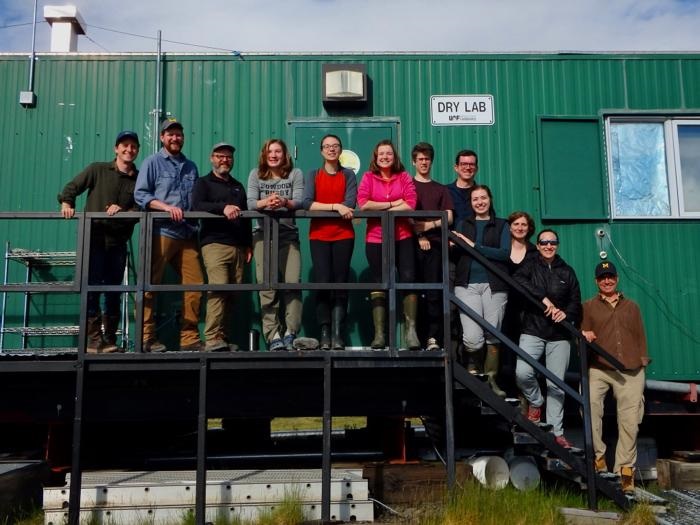
*This program is supported by the National Science Foundation under award 1918637. Any opinions, findings, and conclusions or recommendations expressed by this program are those of the PIs and coordinating team, and do not necessarily reflect the views of the National Science Foundation.
-
PolarTREC - Teachers and Researchers Exploring and Collaborating. https://www.polartrec.com. ↩︎
-
“Why Thawing Permafrost Matters.” State of the Planet, 20 Feb. 2019, http://blogs.ei.columbia.edu/2018/01/11/thawing-permafrost-matters. ↩︎ ↩︎
-
Cory, R. M., et al. “Sunlight Controls Water Column Processing of Carbon in Arctic Fresh Waters.” Science, vol. 345, no. 6199, 2014, pp. 925–928. ↩︎
-
Vallino, J. J., et al. “Modeling Bacterial Utilization of Dissolved Organic Matter: Optimization Replaces Monod Growth Kinetics.” Limnology and Oceanography, vol. 41, no. 8, 1996, pp. 1591–1609. ↩︎
-
Ward, Collin P., and Rose M. Cory. “Chemical Composition of Dissolved Organic Matter Draining Permafrost Soils.” Geochimica Et Cosmochimica Acta, vol. 167, 2015, pp. 63–79. ↩︎
-
Arctic LTER Site Review 2019. National Science Foundation. ↩︎ ↩︎
-
Kaplan, L.A., and R.M. Cory. “Dissolved Organic Matter in Stream Ecosystems: Forms, Functions, and Fluxes of Watershed Tea.” Stream Ecosystems in a Changing Environment, 1st ed., Academic Press, 2016, pp. 241–320. ↩︎ ↩︎
-
Sparkman, O. David. Mass Spectrometry Desk Reference. Global View Publ., 2007. ↩︎
-
Mass Spectrometry. Michigan State University. https://www.chemistry.msu.edu/faculty/reusch/VirtTxtJml/Spectrpy/MassSpec/masspec1.htm. ↩︎
| Attachment | Size |
|---|---|
| Download Report (PDF - 1.3 MB)1.27 MB | 1.27 MB |
This program is supported by the National Science Foundation. Any opinions, findings, and conclusions or recommendations expressed by this program are those of the PIs and coordinating team, and do not necessarily reflect the views of the National Science Foundation.
